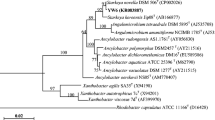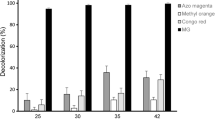Abstract
Organophosphorus compounds are toxic chemicals that are applied worldwide as household pesticides and for crop protection, and they are stockpiled for chemical warfare. As a result, they are routinely detected in air and water. Methods and routes of biodegradation of these compounds are being sought. We report that under aerobic, photosynthetic conditions, the cyanobacterium Anabaena sp. transformed methyl parathion first to o,o-dimethyl o-p-nitrosophenyl thiophosphate and then to o,o-dimethyl o-p-aminophenyl thiophosphate by reducing the nitro group. The process of methyl parathion transformation occurred in the light, but not in the dark. Methyl parathion was toxic to cyanobacteria in the dark but did not affect their viability in the light. Methyl parathion transformation was not affected by mutations in the genes involved in nitrate reduction in cyanobacteria.





Similar content being viewed by others
References
Alexander M (1994) Biodegradation and bioremediation. Academic, San Diego, Calif., pp 1–7, 248–268
Cai Y, Wolk CP (1997) Nitrogen deprivation of Anabaena sp. strain PCC7120 elicits rapid activation of a gene cluster that is essential for uptake and utilization of nitrite. J Bacteriol 179:258–266
De Hoffmann E, Stroobant V (2002) Mass spectrometry: principles and applications. Wiley, New York
Elanskaya IV, Chesnavichene EA, Vernotte C, Astier C (1998) Resistance to nitrophenolic herbicides and metronidazole in the cyanobacterium Synechocystis sp. PCC 6803 as a result of the inactivation of a nitroreductase-like protein encoded by drgA gene. FEBS Lett 428:188–192
Environmental Protection Agency (1998) Methyl parathion: report on the Hazard Identification Assessment Review Committee, US EPA, Washington, D.C. http://www.epa.gov/oppsrrd/op/methyl_parathion.html. Cited 7 July 1998
Esteve-Núñez A, Caballero A, Ramos JL (2001) Biological degradation of 2,4,6-trinitrotoluene. Microbiol Mol Biol Rev 65:335–352
Flores E, Guerrero MG, Losada M (1983) Photosynthetic nature of nitrate uptake and reduction in the cyanobacterium Anacystis nudulans. Biochim Biophys Acta 722:408–416
Goolsby DA, Thurman EM, Pomes ML, Meyer MT, WA Battaglin (1997) Herbicides and their metabolites in rainfall: origin, transport, and deposition patterns across the Midwestern and Northeastern United States, 1990–1991. Environ Sci Tech 31:1325–1333
Goronzy T, Drzyzga O, Kahl MW, Bruns-Nagel D, Breitung J, von Loew E, Blotevogel K-H (1994) Microbial degradation of explosives and related compounds. Crit Rev Microbiol 20:265–284
Guikema JA, Sherman LA (1980) Metronidazole and the isolation of temperature-sensitive photosynthetic mutants in cyanobacteria. J Bioenerg Biomembr 12:277–295
Kuritz T, Wolk CP (1995) Use of filamentous cyanobacteria for biodegradation of organic pollutants. Appl Environ Microbiol 61:234–238
Kuritz T, Bocanera LV, Rivera NS (1997) Dechlorination of lindane by the cyanobacterium Anabaena sp. strain PCC 7120 depends on the function of the nir operon. J Bacteriol 179:3368–3370
Majewski, MS, Capel PD (1995) Pesticides in the atmosphere. Ann Arbor, Mich.
Marvin-Sikkema FD, de Bont JAM (1994) Degradation of nitroaromatic compounds by microorganisms. Appl Microbiol Biotechnol 42:499–507
Megharaj M, Venkateswarlu K, Rao AS (1987) Metabolism of monocrotophos and quinalphos by algae isolated from soil. Bull Environ Contam Toxicol 39:251–256
Megharaj M, Madhavi DR, Sreeinvasaulu C, Umamaheswari A, Venkateswarlu K (1994) Biodegradation of methylparathion by soil isolates of microalgae and cyanobacteria. Bull Environ Contam Toxicol 53:292–297
Mishra AK, Pandey AB (1989) Toxicity of three herbicides to some nitrogen-fixing cyanobacteria. Ecotoxicol Environ Saf 17:236–246
Muškuniene V, Šaralauskas J, Jacquot J-P, Čenas N (1998) Nitroreductase reactions of Arabidopsis thaliana thioredoxin reductase. Biochim Biophys Acta 1366:275–283
Mulbry WW, Karns JS (1989a) Parathion hydrolase specified by the Flavobacterium opd gene: relationship between the gene and protein. J Bacteriol 171:6740–6746
Mulbry WW, Karns JS (1989b) Purification and characterization of three parathion hydrolases from Gram-negative bacterial strains. Appl Environ Microbiol 55:289–293
Mulbry W, Rainina E (1998) Biodegradation of chemical warfare agents. ASM News 64:325–331
US General Accounting Office (2003) Chemical weapons. Sustained leadership along with key strategic management tools is needed to guide DOD’s destruction program. Report to congressional committees, GAO-03-1031, September 2003, Washington, D.C.
Orus MI, Marco E (1991) Disappearance of trichlorophon from cultures with different cyanobacteria. Bull Environ Contam Toxicol 47:392–397
Pavlosthatis SG, Jackson GH (1999) Biotransformation of 2,4,6-trinitrotoluene in Anabaena sp. cultures. Environ Toxicol Chem 18:412–419
Pavlosthatis SG, Jackson GH (2001) Biotransformation of 2,4,6-trinitrotoluene in a continuos-flow Anabaena sp. system. Water Res 36:1699–1706
Rieble S, Joshi DK, Gold MH (1994) Aromatic nitroreductase from the basidiomycete Phanerochaete chrysosporium. Biochem Biophys Res Commun 205:298–304
Rippka R, Deruelles J, Waterbury JB, Herdman M, Stanier RY (1979) Generic assignments, strain histories and properties of pure cultures of cyanobacteria. J Gen Microbiol 111:1–61
Schmetterer G (1994) Cyanobacterial respiration. In: Bryant DA (ed) The molecular biology of cyanobacteria. Kluwer, Dordrecht, pp 409–435
Singh PK (1973) Effect of pesticides on blue-green algae. Arch Microbiol 89:317–320
Spain JC (1995) Biodegradation of nitroaromatic compounds. Annu Rev Microbiol 49:523–555
Subramanian G, Sekar S, Sampoornam S (1994) Biodegradation and utilization of organophosphorus pesticides by cyanobacteria. Int Biodeter Biodegr 33:129–143
Acknowledgements
The authors thank L. Renee Rodgers, Alexander Francisco, and K. Thomas Klasson for technical assistance, and Elizabeth T. Owens for reviewing the manuscript. This research was supported by ORNL Laboratory-Directed Research and Development Program. ORNL is managed by UT-Battelle, LLC for the US Department of Energy under contract DE-AC05-00OR22725.
Author information
Authors and Affiliations
Corresponding author
Rights and permissions
About this article
Cite this article
Barton, J.W., Kuritz, T., O’Connor, L.E. et al. Reductive transformation of methyl parathion by the cyanobacterium Anabaena sp. strain PCC7120. Appl Microbiol Biotechnol 65, 330–335 (2004). https://doi.org/10.1007/s00253-004-1557-y
Received:
Revised:
Accepted:
Published:
Issue Date:
DOI: https://doi.org/10.1007/s00253-004-1557-y




